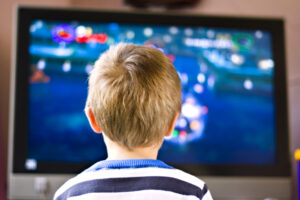Navigating the Digital Landscape: A Mom’s Guide to Managing Screen Time
In a world that seems increasingly digital, managing screen time with our little ones has become a delicate dance. As we navigate this digital landscape, it can be difficult to find that sweet spot between embracing the benefits of technology and ensuring a healthy balance for our kids. Here are a few tips to help your family maintain a healthy relationship with technology in our digital world.
The Latest Research: Insights into Screen Time
While concerns exist about the potential drawbacks of excessive screen exposure, the latest research suggests that nuance lies in understanding that it’s not a one-size-fits-all scenario. Quality far outweighs quantity, and the nature of the content our children engage with matters.
The American Academy of Pediatrics (AAP) suggests that for children aged 18 to 24 months, screen time should be limited to high-quality programming, viewed alongside a caregiver to help them understand what they are seeing. For children aged 2 to 5 years, it is recommended to limit screen use to one hour per day of high-quality programs. Be yond these guidelines, it becomes increasingly important for parents to be aware of the digital content their children encounter, and to ensure that the content they’re consuming is appropriate for their age and stage of development.
yond these guidelines, it becomes increasingly important for parents to be aware of the digital content their children encounter, and to ensure that the content they’re consuming is appropriate for their age and stage of development.
The research highlights the importance of interactive engagement over passive consumption. Rather than a blanket condemnation of screen time, experts have noted the potential benefits of educational apps and even digital games that encourage problem-solving and interactive experiences. As moms, our role is not just to restrict but to guide, ensuring that screen time is purposeful and helpful for our children’s development.
Balancing Act: Striking the Right Proportion
As mothers, we understand the infinite demands on our time and energy, and screens can, at times, provide some much needed relief. With this in mind, consider creating a schedule that designates specific times for screen engagement. This intentional approach not only provides structure but also instills a sense of balance in your children’s minds from day one.
Of course, screens are not an all-encompassing solution. As moms, we can rely on our instincts and wisdom discern when a screen can be a valuable tool and when it should be put away in favor of real-life interactions.
Using this approach allows kids to learn the importance of moderation, the art of time management, and the importance of varied activities that contribute to their growth. Like us, children can begin to recognize screens as tools that can both educate and entertain, all while ensuring they remain secondary to the vibrant, real-life moments that define childhood.
Quality Content Matters: Choose Wisely, Explore Together
In the world of screens, what our kids watch really matters. It’s not just about how long they stare at screens; it’s about what they’re consuming during their screen time. As moms, we can help our children to choose quality content that lines up with family values and helps our kids learn while having fun.
Look for apps and games that spark creativity, stories that make them love reading, and games that make them think. Educational videos that show how people live in other places, interesting virtual trips, and other valuable content can not only entertain our children, but allow them to have virtual experiences that expand their understanding of the world.
Even more importantly, talk about your child’s screen time experiences with them. Ask them what they think, what they enjoy, and share your thoughts too. Turning screen time into a conversation makes it more than just watching – it becomes a time for bonding and understanding.
Modeling Healthy Habits: Leading by Example
We would be remiss to fail to acknowledge the impact of leading by example in this arena. Children learn by observing, and our habits influence theirs. Be mindful of your own screen time, and strive to model healthy digital behaviors. By demonstrating a balanced approach, you’re instilling valuable habits that will serve them well as they grow.
Ultimately, amidst the pixels and screens, the heart of childhood lies in moments of genuine connection. Work toward a balance that prioritizes real-life experiences – outdoor adventures, family dinners, bedtime stories. These are the timeless moments that contribute profoundly to your child’s development, and the memories that will continue to have a positive impact on them long after they are grown.
